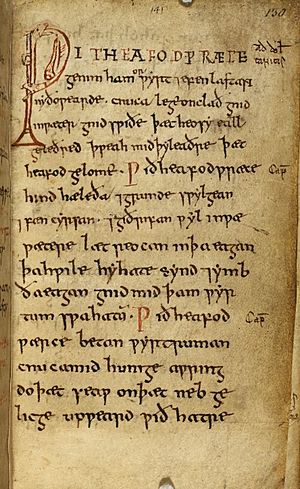Against a dwarf facts for kids
The "Against a dwarf" charms are ancient spells from a time long ago called the Anglo-Saxon period in England. These special charms are found in an old book called the Lacnunga. People used them to try and heal someone who was sick. They believed that a "dwarf" – not a small person, but a kind of spirit or creature – was causing the illness.
Contents
Ancient Charms Against Illness
These charms are like old medical remedies mixed with magic and prayers. They show us how people in the past tried to understand and fight sickness. Three of these charms are specifically called "Against a dwarf" (which in Old English was Ƿið dƿeorh).
Healing with Symbols and Herbs
Two of these charms, known as LXXXVIIc and LXXXVIIIc, involved writing special symbols on the sick person's arms. These symbols included crosses and letters from both the Latin and Greek alphabets.
After writing the symbols, people would mix a plant called celandine with ale (a type of drink). They would then call out the names of saints, including a Welsh saint named Macutus. This was all part of the healing process they believed in.
The Detailed Dwarf Charm
The charm known as XCIIIb is the most detailed one. It starts with a very interesting step: writing names on special bread wafers, similar to those used in church. The names written were those of the Seven Sleepers of Ephesus. These were legendary figures from a Christian story.
After writing the names, a special chant or spell, called a galdor, was sung. This chant was sung first into the sick person's left ear, then their right ear, and finally above their head.
Here is what the old spell says in English:
|
Wið dweorh: man sceal niman .VII. lytle oflætan swylce man mid ofrað ⁊ wri[t]an þas naman on ælcre oflætan: maximianus malchus. iohannes. Martinianus. dionisius. con-stantinus. serafion. þænne eft þæt galdor þæt [man] her æfter cweð[eð] man sceal singan, ærest on þæt wynstre eare, þænne on þæt swiðre eare, þænne [b]ufan þæs mannes moldan; ⁊ ga þænne an mædenman to ⁊ ho hit on his sweoran, ⁊do man swa þry dagas. him bið sona sel. |
Against dwarf: one must take seven small wafers such as are used for Communion, and write these names on each wafer: Maximianus, Malchus, Johannes, Martinianus, Diony-sius, Constantinus, Seraphion. Then, next, the spell that is quoted hereafter is to be sung, first in the left ear then in the right ear, then above the man’s head; and then let a virgin approach and hang it on his neck, and let this been done in this way for three days. It will go better with him directly. |
| —Old English text | —Hines Translation |
After the chanting, a young woman (a virgin) would hang the wafers around the sick person's neck. This whole process was repeated for three days. People believed that doing this would make the sick person feel better very quickly.
See also
- Apotropaic magic
- Canterbury charm
- Kvinneby amulet
- Sigtuna amulet I


